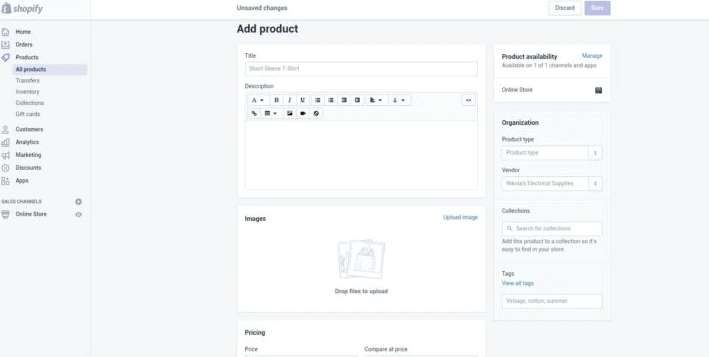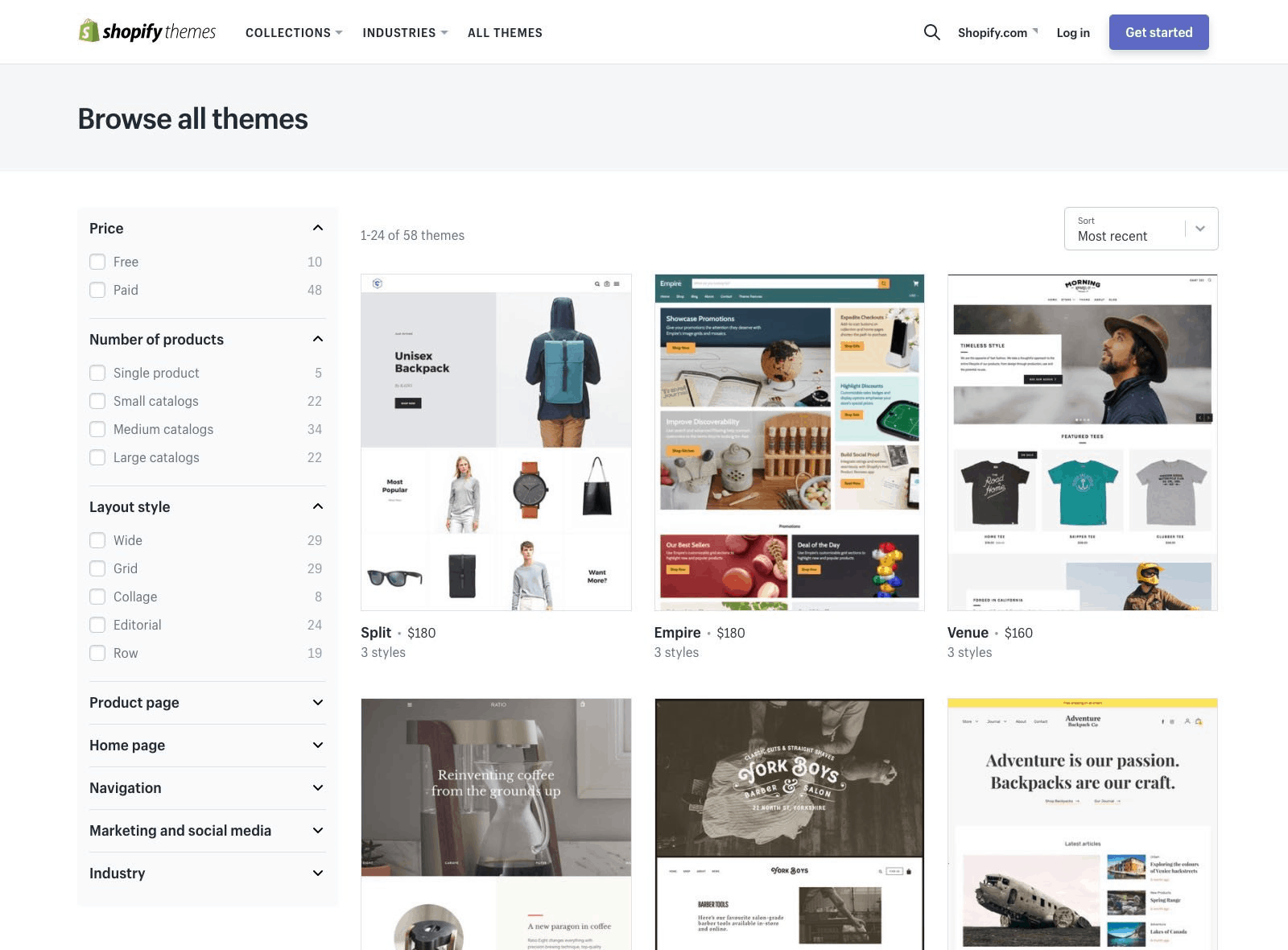As Bill Gates quotes: “Tomorrow’s Leaders Will be Those That Empower Others”.
The same goes with Shopify which empowers people either from tech or non-tech backgrounds to create professional-looking online stores and create magic!
Shopify Inc. is a multinational e-commerce company that offers online retailers services including payments, marketing, shipping, and customer engagement tools. Shopify is also the name of its proprietary e-commerce platform that is for online stores and retail point of sale systems. It was founded in 2006 by Tobias Lutke, Daniel Weinand, and Scott Lake. Its headquarters is in Ottawa, Ontario, Canada. According, to the company’s report it had more than 17,00,000 businesses in approximately 175 countries using its platform as of May 2021.
According to Builtwith, a total of 1.58 million websites run on Shopify as of 2021. The total gross merchandise volume in the year 2019 exceeded the US $61 billion. Shopify is the largest traded publicly traded Canadian company by market capitalization, as of 2021. Shopify serves worldwide with a total of 7000+ employees.
Index:
How Shopify works?
There are only 9 easy steps to create a beautiful Shopify store.
- Sign up: When you head into Shopify.com, you just have to click the Get started button and have to give your email address. And that’s it enjoy your 14 days free trial. Shopify will then ask you to fill in some details like email, password of your choice, and most importantly your store name, which should be unique.
- Add products: After filling out the details, you will see that you have been taken to the admin page, there you will see 3 options in the middle add product, customize the theme and add domain. So, you just have to start by adding the products that you want to sell, click the blue button to start selling physical, digital, or service items.

3. Customize theme: To make your shop look more classy and attractive, you have to customize the theme of your choice. Click the blue button which shows customize the theme, and customize it by editing text, adding images. To update the home page background, click the blue button so that you can update your own. You can also choose template images from there, which cover many industries.

4. Add domain: Your domain is the very first thing that your customer will see, so it’s important to find the perfect URL for your online store which will make your brand look stronger.
5. Enable payments: Now about payments, so with Shopify, there are no transaction fees, but if you want to go through Paypal, Amazon Pay, or any other options then you have to charge per transaction. To go to the payment page, click on settings then go to the Payment providers icon, and there you can pay there.
6. Add shipping: To go for shipping, go to the settings option and then click on the shipping icon. Here, you can add shipping zones, buy shipping labels and you can decide how much you want to charge from your customer.
7. Choose a price plan: Before actually publishing your Shopify store, you’ll first have to pay Shopify to keep using the platform after 14 days of trial. You will also need to upgrade your site, you will have to go to the “select a plan” button at the foot of every page. The Shopify plans are as follows:
- Basic Shopify ($29 per month)
- Shopify ($79 per month)
- Advanced Shopify ($299 per month)

8. Publish your Shopify store: When you are satisfied and happy with your Shopify store, you need to share it with the world. To get your site live, you’ll first need to upgrade to a paid plan, then from the Shopify admin page, go to ‘Online store’, then go to ‘Preferences’, and then uncheck ‘Enable password’ within the ‘Password protection’ area.
And that’s it you are good to go.
Business Model:
Key Partners:
Shopify work with so many partners such as Stripe Inc., Langify, Zapier, and Vantage. The partners are organized into the following categories:
- Affiliate and Marketing partners
- Development and Integration partners
- Strategic and Alliance partners
- Supplier and Vendor partners
Key Activities:
The Shopify platform offers users a single view of their customers and business and allows them to manage all the products and inventories, process orders and payments, build relationships with customers, and reporting all from one location. Shopify operates as a cloud-based, multi-channel e-commerce platform designed for all small as well as medium-sized businesses. Shopify also offers functionality through its mobile app for Android as well as for iOS, which enables users to manage their business.
Key Resources:
Shopify has several key resources such as its technologies and intellectual properties, its communication and IT infrastructure, the online platforms, its network of partners, its R&D facilities and personnel.
Also recently they introduced Shopify plus academy for educating its customers from e-commerce experts.
Value propositions:
Shopify’s value propositions are its brand identity and reputation particularly in its core North American markets, its accessibility and ease of use for customers without any assistance from Shopify staff, its technology and innovation for the development of its online platform, and substantial resources to the development of innovative technologies, its cost-effectiveness and its breadth of functionality offering a broad range of tools and functionality which enables customers to set up and operate online stores.
Customer Relationship:
Shopify operates a self-service business and is able to set up an account, design and operate an online store, with subscription fees, manage inventories and online payments without the direct assistance of Shopify employees. The members of Shopify can be reached 24×7 over email, phone, or via an online chat service. The company additionally offers a wide range of online resources, FAQs video,s and podcasts for the users. The company also gets in touch with customers or users with the help of social media accounts.
Customer Segments:
The most important customers for Shopify are Independent Retailers which comprise independent and individual designers, resellers, etc, and Commercial Retailers which comprise larger retail businesses.
Channels:
Shopify serves its customers directly through its e-commerce platform which provides its customers a range of tools and functions. Shopify also offers its customers functionality through its mobile which is available either on Android or iOS.
Cost Structure:
Shopify recorded a total $128 operating expense in 2015. Shopify comprises of 82 million marketing expenses and #39.72 million of R&D expense and general and administrative expenses of $18.73 million.
Revenue Streams:
Shopify generates revenue through the provision of e-commerce solutions to small and medium-sized businesses. Shopify earns the revenue from the subscriptions which come in 3 tiers.
Subscription starts out at $13 per month for basic, for a standard account, it is $54 per month and $107 advanced account per month. In 2020 the company recorded the revenue at $2,929 million as compared to $1,578 million in 2019 which is almost double.
Valuation, expenses, and revenue:
1.58million websites run on Shopify according to Builtwith as of 2021. As of 2019, Shopify’s total gross merchandise volume exceeded the US $61 billion. Total revenue for the year 2020 is $2,929 million as compared to $1,578 million in 2019. Now, let us see a graph of Shopify’s annual revenue:

Investor’s Details and funding:
The total funding amount of Shopify is $122.3 million after 4 funding rounds. There were total 5 lead investors and 8 numbers of investors.
Competitor Analysis:
- WooCommerce
- BigCommerce
- Ecwid
- Miva
“Is Shopify profitable”?
Yes, Shopify is profitable and is increasing rapidly. The revenue of the year 2020 is almost double as compared to 2019.
Do Share Your Thoughts:
Do tell us all your thoughts in the comments section below, we look forward to reading all the comments in the section below.
Also, do check useful Startup Resources and Tools below and do join our newsletter 📰 for free for more interesting Business Case Studies 💰, Startup Insights 🚀, and Startup founders podcast 🎙️ delivered to your inbox every Sunday morning.
Do follow us:
Related Articles:
- ChaCha Business Model Breakdown: Why ChaCha failed?
- Peloton Business Model: How Peloton makes money?
- Zelle Business Model Breakdown: How Zelle makes money?
- Robinhood Business Model Breakdown: How Robinhood makes money?
- ALDI Business Model Breakdown: How ALDI makes money?
- Afterpay Business Model: How AfterPay makes money?
What is Shopify?
Shopify Inc. is a multinational e-commerce company that offers online retailers services including payments, marketing, shipping, and customer engagement tools. Shopify is also the name of its proprietary e-commerce platform that is for online stores and retail point of sale systems.
Who founded Shopify?
Shopify was founded in 2006 by Tobias Lutke, Daniel Weinand, and Scott Lake. Its headquarters is in Ottawa, Ontario, Canada.



